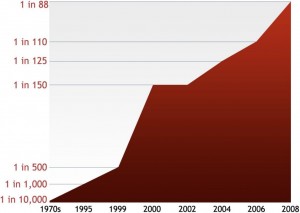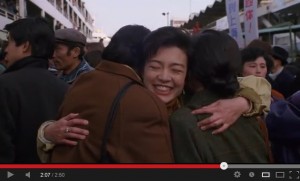Will it bloom this year?
Legislative bodies seem to enjoy designating this or that day, week, or month as a time for everyone to acknowledge the importance some worthy cause. To me, those proclamations generally seem like pointless exercises and a distraction from the things elected representatives ought to be doing. For example, I like plumbers as much as anybody, but who really cares if March 11 is World Plumbing Day?
National School Lunch Week, Great Outdoors Month, and their like come and go without affecting me in the slightest.
However, April, that cruellest of months, happens to have been set aside for commemorating two issues that have had devastating effects on my family and a great many others.
National Autism Awareness Month
A new study from the CDC tells us that the autism rate in the U.S. is now 1 in 50. That’s 80,000 kids each year. The population of, say, Gary, Indiana. Every year. And since boys with autism outnumber girls by a ratio of 4 or 5 to 1, slightly more than 3 percent of all American boys have an autism spectrum diagnosis.
With numbers like that, it’s entirely appropriate to call for us as a society to recommit to dealing with the crisis.
What we really want, of course, is visible progress toward (1) an understanding of the real causes, (2) effective treatments, and (3) prevention. Over the years, I’ve read a lot of articles and have attended a lot of presentations that gave the impression that we were further along the road toward those goals than we really are.
To the extent that progress is influenced by outlays of government money for research, perhaps legislative bodies might hasten things along. We can agitate for them to try, and many of us do, but I believe the people controlling the purse strings will always have other priorities.
Aside from that, the only option I can think of is to be aware. Those of us with children in our future ought to know as much as possible about the risk factors and early warning signs. (Lists of either are beyond the scope of this piece, but to pick an example here’s a rather scary item you might want to read.) I disagree with those who go out of their way to avoid scaring people, when fear could provide motivation to do something constructive.
Everyone contemplating having children should understand that screening and early intervention is key to improved outcomes for kids with developmental problems. Regardless of what your pediatrician may try to tell you.
And those of us as yet untouched by all this can endeavor to be understanding and patient when we inevitably encounter it in public.
Cancer Control Month
Cancer is the second most common cause of death in the U.S., exceeded only by heart disease. One out of every four deaths in the U.S. results from cancer. By my figures, that’s 625,000 people dying each year, some still young. The population of Boston, every year. Screening and therapies have improved over time, of course, and lots of people diagnosed with cancer do not die from it. Still, the number of new cases is increasing. As with autism, there’s an urgent need for continuing research, aimed at finding real-world solutions, and for awareness. As with autism, the reality of a diagnosis may be closer than any of us thinks.
Again with the scare tactics. Forgive me. Normal human thinking seems to involve an optimism bias. That is, we know bad things happen to other people in situations like ours, but we tend to believe they won’t happen to us. However, learning a little about those bad things might prepare us for making wise choices.
There doesn’t appear to be one single cause for either of these threats. Genetics is evidently involved in both, or more likely there’s an interaction between genes and circumstances. Looking at my own family, I see a few risk factors for both autism and cancer. (There’s some overlap.) But no doubt other families manage to get by just fine with the same cocktail of hazards. My family also made conscious decisions to reduce our risk—unsuccessfully, as it turned out.
These are very complicated subjects, and it’s not surprising that confusion still reigns. (I do think we’ve got it in us to do a little better.) I guess, if the government can’t pay for a resolution, their calling attention to the crises is at least a nice gesture.
TS Eliot’s poem The Waste Land notes that April is the time when our world should be regenerating after a long winter. In the poem, that renewal brings pain, because it suggests a more carefree time in the past. For me, and for a great many others, fresh spring air evokes memories of a time before autism (or something like it) took my first child and cancer took my first wife.
Now, my daughter (a perfect representation of new hope in my own life story) reminds me that I shouldn’t end this with such a defeatist note. Given that we do live with the threat of these things, and sometimes more than a threat, we also need reminders that there may yet be profound joy on the other side of loss. In that spirit, here’s the concluding scene of The Joy Luck Club, which is often in my mind. Just click the image below.
Hat tip to Talk About Curing Autism for the graph above.
An edited version of this article appeared in The San Diego Reader.
Tags:

